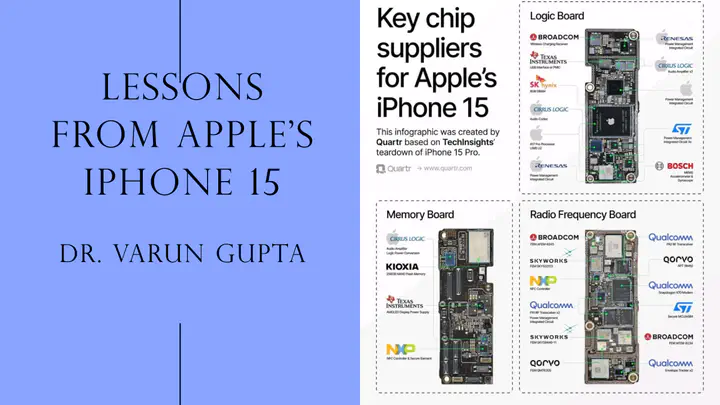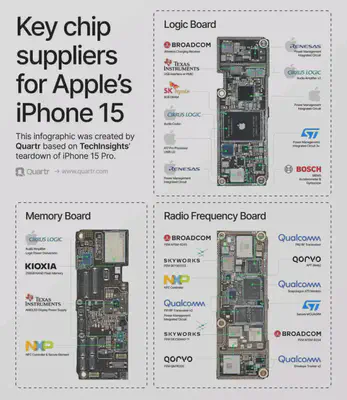🔍 Diversification in Tech Supply Chains: Lessons from Apple's iPhone 15 📱🤳

I came across a fascinating infographic detailing the chip suppliers for Apple’s iPhone 15.

Apple utilizes a variety of suppliers to source chips for iPhone 15.
As a supply chain management expert, this sparked some intriguing thoughts on supplier diversification and risk mitigation strategies in high-tech industries. Let’s look the details! 🏊♂️
Introduction
Apple, like many tech giants, faces significant challenges in managing its complex supply chain:
• Global chip shortages 🌐
• Geopolitical tensions affecting trade 🌍
• Rapid technological advancements 🚀
• Sustainability pressures 🌱
These factors create a perfect storm of supply chain complexity, requiring innovative approaches to ensure resilience and continuity.
How Supplier Diversification Helps Apple:
Apple’s strategy, as evident from the iPhone 15 chip supplier list, showcases effective supplier diversification:
-
Geographic Spread: Suppliers from multiple countries (US, South Korea, Japan) 🗺️
-
Capability Variety: Mix of specialized (e.g., Skyworks for RF) and multi-capable suppliers (e.g., Qualcomm) 🔧
-
Size Balance: Blend of tech giants (Broadcom, Qualcomm) and smaller specialists (Qorvo, Cirrus Logic) ⚖️
This approach helps Apple:
• Mitigate regional supply disruptions
• Access best-in-class technologies
• Maintain negotiating power
• Reduce dependency on single sources
Insights for Supply Chain Managers
-
Map your supply network thoroughly, including tier 2 and 3 suppliers 🗺️
-
Develop multi-sourcing strategies for critical components 🔄
-
Invest in supplier relationship management across diverse partner types 🤝
-
Stay agile and ready to pivot sourcing strategies as geopolitical landscapes shift 🏃♀️
-
Balance cost efficiencies with resilience in supplier selection 💰🛡️
Future Trends in Diversification
-
Nearshoring: Expect increased focus on regional supply clusters to reduce logistics risks 🏭
-
Onshoring: Critical components may see domestic production boosts, especially in semiconductors 🏗️
-
AI-driven supply chain mapping and risk assessment 🤖
-
Increased emphasis on supplier sustainability credentials 🌿
-
Blockchain for enhanced supply chain transparency and traceability 🔗
Conclusion
Apple’s approach to chip supplier diversification for the iPhone 15 offers valuable lessons for all industries grappling with supply chain complexities. By strategically spreading risk and fostering a diverse supplier ecosystem, companies can build resilience against disruptions while driving innovation.
As we observe an increasingly uncertain global landscape, the ability to maintain a flexible, diversified supply chain will be a key differentiator for successful businesses. 📚💡
#SupplyChainManagement #SupplierDiversification #TechIndustry #RiskMitigation #Innovation
Chip Suppliers for iPhone 15 (as per infographic):
Logic Board: Broadcom, Texas Instruments, SK hynix, Cirrus Logic, Apple, Renesas, ST Microelectronics, Bosch
Memory Board: Cirrus Logic, Kioxia, Texas Instruments, NXP
Radio Frequency Board: Broadcom, Skyworks, NXP, Qualcomm, Qorvo, ST Microelectronics
What do you think about supplier diversification strategies? How is your industry adapting to supply chain challenges? Let’s discuss this in the comments! 👇💬